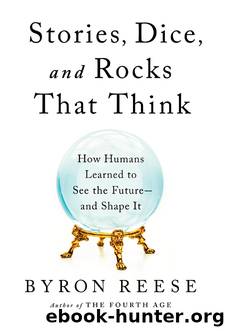Stories, Dice, and Rocks That Think by Byron Reese

Author:Byron Reese
Language: eng
Format: epub
ISBN: 9781637741351
Publisher: BenBella Books
Published: 2022-05-19T00:00:00+00:00
The Problem of Points
As math problems go, it is ridiculously simple. Two guys, Harry and Tommy, are playing a game of chance for a sum of money. In this game, a coin is flipped, and every time heads comes up, Harry gets a point. For each tails, Tommy scores. They agree to flip the coin five times, with the first person to three winning the whole pot. However, their game is interrupted and cannot be completed (I donât know, maybe someone stole their only coin) when Harry has two points and Tommy has one. What is the fair way to decide how to split the pot?
Think carefully about this problem. We will be coming back to it repeatedly. But before you read on, think about how you would solve it. How would you split the pot?
You can solve this problem a few ways. First, you can say that the two final tosses would have gone one of four ways: HH, HT, TH, TT. Given that in three of those four Harry would win, he should get three-fourths of the pot. Or, you could say that for Tommy to win the pot, toss four has to be tails, which happens half the time, and toss five has to be tails as well, which will happen in only half of those times. Thus you can determine that Tommy has only a 25 percent chance of taking the pot and therefore should get a quarter of it. Same answer.
Today, it is the sort of problem that wouldnât even earn a middle schooler a smiley-face stamp on their homework. And yet, it stumped the greatest mathematicians of their day for centuries. Let me say that again very plainly: this is a math problem no one could solve until 1654 when two intellectual giants swapping letters in France finally managed to crack it through effort, debate, and introspection.
The two men were Blaise Pascal, a thirty-one-year-old French mathematician who had fame as a prodigy in his teens, and mathematician Pierre de Fermat, age forty-six. They were both fascinating characters: Pascal mastered a wide range of scientific topics at an early age and had even helped support his family by designing and selling a mechanical calculator when he was just eighteen. Fermat spoke six languages, wrote poetry, and was only a hobbyist mathematicianâearning his living as a lawyerâand yet contributed more to the field than Pascal, who would abandon math in favor of theology and die before his fortieth birthday. The problem of points had been put to them by another Frenchman, Chevalier de Méré, and Pascal and Fermat began working on it.
It was a well-known problem, and several potential solutions had been offered, but they were all wrong. Before we get to the story of how it was ultimately solved, letâs trace the history of the problem and the various incorrect solutions.
In 1494, a friar named Luca Pacioli, a friend of Leonardo da Vinci, posed it in a book called Everything about Arithmetic, Geometry, and Proportions.
Download
This site does not store any files on its server. We only index and link to content provided by other sites. Please contact the content providers to delete copyright contents if any and email us, we'll remove relevant links or contents immediately.
| American National Standards Institute (ANSI) Publications | Architecture |
| History | Measurements |
| Patents & Inventions | Research |
Whiskies Galore by Ian Buxton(41812)
Introduction to Aircraft Design (Cambridge Aerospace Series) by John P. Fielding(33049)
Small Unmanned Fixed-wing Aircraft Design by Andrew J. Keane Andras Sobester James P. Scanlan & András Sóbester & James P. Scanlan(32731)
Craft Beer for the Homebrewer by Michael Agnew(18123)
Turbulence by E. J. Noyes(7921)
The Complete Stick Figure Physics Tutorials by Allen Sarah(7291)
Kaplan MCAT General Chemistry Review by Kaplan(6852)
The Thirst by Nesbo Jo(6810)
Bad Blood by John Carreyrou(6523)
Modelling of Convective Heat and Mass Transfer in Rotating Flows by Igor V. Shevchuk(6378)
Learning SQL by Alan Beaulieu(6192)
Weapons of Math Destruction by Cathy O'Neil(6117)
Man-made Catastrophes and Risk Information Concealment by Dmitry Chernov & Didier Sornette(5904)
Digital Minimalism by Cal Newport;(5633)
Life 3.0: Being Human in the Age of Artificial Intelligence by Tegmark Max(5447)
iGen by Jean M. Twenge(5352)
Secrets of Antigravity Propulsion: Tesla, UFOs, and Classified Aerospace Technology by Ph.D. Paul A. Laviolette(5299)
Design of Trajectory Optimization Approach for Space Maneuver Vehicle Skip Entry Problems by Runqi Chai & Al Savvaris & Antonios Tsourdos & Senchun Chai(4996)
Electronic Devices & Circuits by Jacob Millman & Christos C. Halkias(4890)
